Types of Outdoor Bikes: Exploring Top Choices for Your Next Adventure


In recent years, advancements in technology and design have led to the development of various types of outdoor bikes, each tailored to specific terrains and riding styles.
Outdoor bicycling enthusiasts have a wide range of options when it comes to choosing the perfect bike for their needs.
In this article, we will discuss some of the most popular types of outdoor bikes available today, including mountain bikes (MTB), hybrid bikes, and gravel bikes.
When selecting an outdoor bike, it’s essential to consider the type of terrain and riding conditions we plan to encounter.
Different types of outdoor bikes are optimized for various surfaces, from smooth pavement to off-road trails, and have features designed to enhance our biking experience. If you want to stay fit and you are looking for best cycling bike outdoors, they are also available in the market.
As we explore the world of outdoor bikes, we will delve into the unique characteristics of MTB, hybrid bikes, and gravel bikes, highlighting their respective strengths and the specific terrains for which they are best suited.
With this knowledge, we can confidently select a bike that will provide us with countless hours of enjoyable outdoor exercise and adventure.
Understanding Different Types of Outdoor Bikes
When it comes to outdoor cycling, we can identify several different types of outdoor bikes to suit various terrains and riding experiences.
By understanding the unique features and capabilities of each type of outdoor bikes, you can make an informed choice about the best bike for your needs.
Mountain Bikes are built for rough and rugged terrain. With their wide, knobby tires and durable suspension systems, these outdoor bikes can tackle steep inclines, rocky paths, and root-strewn trails with ease. You can find more information about mountain bikes on Verywell Fit.
Hybrid Bikes are versatile bicycles designed for both on and off-road cycling. Their larger wheel size and wide, semi-slick tires provide stability and grip on various surfaces, making them suitable for commuting, leisure rides, and light trail use.
Gravel Bikes are designed for tackling mixed terrain, including gravel, dirt, and pavement. This type of outdoor bikes are built with drop handlebars, similar to road bikes, and have wider tires for enhanced traction on loose surfaces. To explore gravel bikes in depth, visit Cyclingnews.
Touring Bikes are optimized for long-distance riding and carrying loads. They feature comfortable, upright riding positions and robust frames capable of handling extra weight from luggage or gear. To find details about touring bikes, refer to Verywell Fit.
Finally, E-Bikes come in various forms, incorporating electric assistance into road, mountain, or hybrid bikes.
These bikes have lightweight motors to assist with pedaling, making them perfect for long rides or steep inclines where extra power is appreciated.
Each type of bike brings unique features to the table, allowing you to customize your riding experience based on your preferences and the terrain you wish to explore.
By understanding the characteristics of each category, you’ll be well-equipped to make the perfect choice for your cycling adventures.
1. Road Bikes
Road bikes are designed for fast and efficient riding on paved roads. They are lightweight and have a narrow tire profile to minimize rolling resistance.
We can classify road bikes into various sub-types such as race, endurance, and gravel bikes, among others.
Features
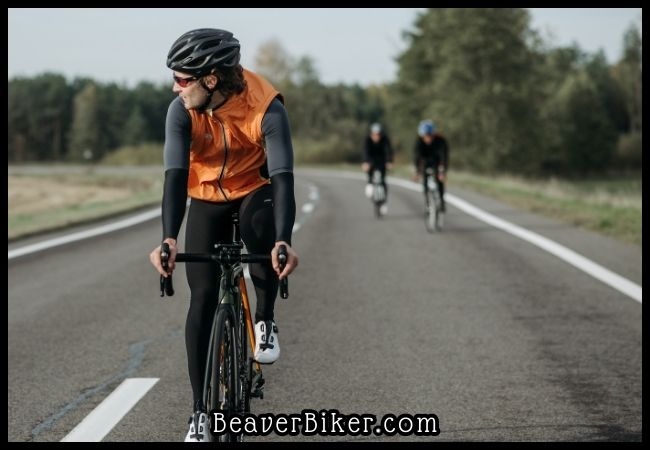

Road bikes typically feature:
- Drop handlebars, allowing for multiple hand positions and aerodynamic riding.
- 700c wheels, offering a good balance between speed and control.
- Higher gear ratios for faster speeds.
- Lightweight frames made of materials like carbon, aluminum, or titanium.
- Disc brakes or caliper brakes, depending on the model and budget.
Pros and Cons
Pros:
Some advantages of road bikes are:
- Speed and efficiency on paved roads
- Lightweight and easy to maneuver
- Wide range of gears for climbing hills and racing
- Aerodynamic design helps in reducing wind resistance
Cons:
However, road bikes also have some disadvantages:
- Not well-suited for rough terrain or off-road use
- Thin tires are prone to punctures and can be less comfortable over long distances
- Drop handlebars might not suit everyone’s riding style
Best Suited For
Road bikes are perfect for cyclists who primarily ride on paved surfaces and seek speed and performance during their rides. They are suitable for:
- Long distance riding
- Racing and fast group rides
- Regular commuting and city riding
- Endurance and sportive events
Overall, road bikes are an excellent choice for riders looking to conquer pavement and reach new speed milestones.
2. Mountain Bikes
Features
Mountain bikes are designed to handle all types of off-road terrain, providing a versatile and durable option for those who love adventure. They typically have wide, knobby tires for improved traction and better grip on rough surfaces.
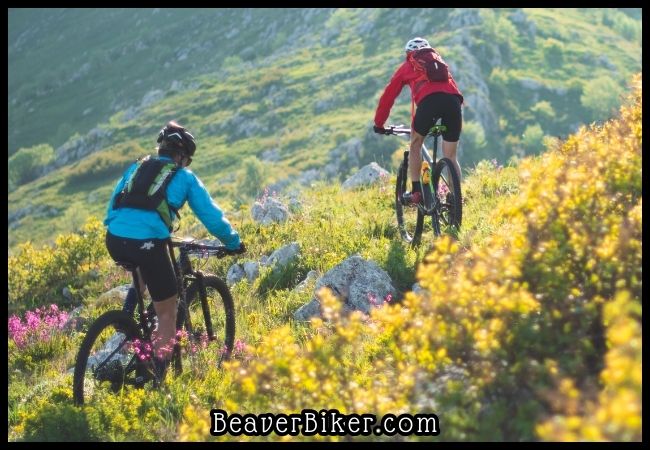

Most mountain bikes make use of full or front suspension systems, which provide increased shock absorption and smooth out bumps on the trails.
The frame geometry is designed for stability and control, with a wide range of gears to make it easier to tackle steep climbs and descents.
Pros and Cons
Pros: There are several advantages to using mountain bikes, such as:
- Excellent off-road performance and ability to handle various terrains
- Durable and sturdy construction
- Great traction and grip provided by wide, knobby tires
- Increased comfort and control through suspension systems
Cons:
- However, there are also some drawbacks to consider:
- Heavier and slower than other types of bikes, especially on paved surfaces
- Not all mountain bikes are suitable for aggressive downhills or highly technical trails
- Higher maintenance requirements due to exposure to rough terrain and elements
Best Suited For
Mountain bikes are an ideal choice for those who enjoy cycling through nature and have a passion for exploring off-road trails. They are perfect for riders that prioritize stability, control, and comfort in challenging environments.
There are various subcategories of mountain bikes specialized for different types of riding, such as cross-country, trail, enduro, and downhill.
By knowing your preferred riding style and the terrain you’ll encounter, it’s easier to choose the right mountain bike that complements your specific needs and preferences.
3. Hybrid Cycling
In this section, we will focus on hybrid bikes, their features, pros, cons, and for whom they are best suited.
Hybrid bikes are designed for a range of fitness and commuting activities, combining aspects of road and mountain bikes for a versatile cycling experience.
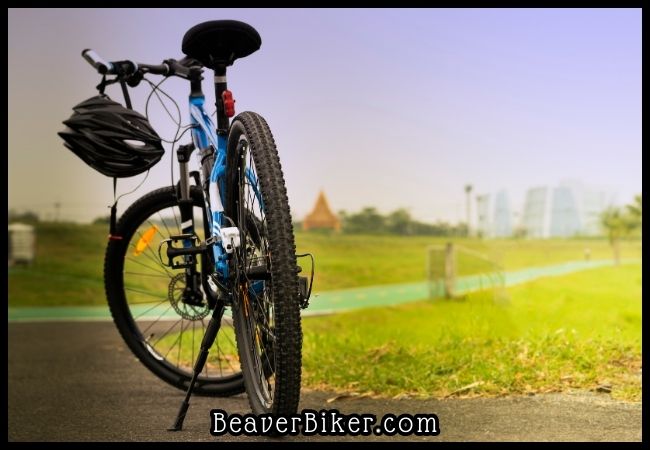

Features
Hybrid bikes, as the name suggests, possess a mix of characteristics from both road and mountain bikes, offering a comfortable and efficient ride. Some common features include:
- Wide, comfortable seats
- Flat handlebars for an upright riding position
- Medium-sized, semi-slick tires for smooth and easy rides
- Disc or V-brakes for reliable stopping power
Pros and Cons
Now let us enumerate some of the advantages and drawbacks of hybrid bikes:
Pros:
- Comfortable for long rides
- Good adaptability to various terrains
- Usually equipped with mounting points for racks and fenders
- Accessible and easy to use for beginners
Cons:
- Heavier than road bikes
- Less efficient than specialized bikes for specific terrains
- Not as durable as mountain bikes for extreme off-road use
Best Suited For
Hybrid bikes are an excellent choice for individuals seeking versatility and general-purpose use. They are suitable for:
- Commuting and city riding
- Fitness and leisure riding
- Light off-road trails and gravel paths
Efficient and adaptable, hybrid bikes are a great option for those who want to maximize their cycling experience without committing to a specialized bike type.
4. Cruiser Biking
Cruiser bikes, also known as beach cruisers, are a popular choice for casual and leisurely rides. These bikes are designed with comfort and style in mind, making them a great option for relaxed outings and short commutes.
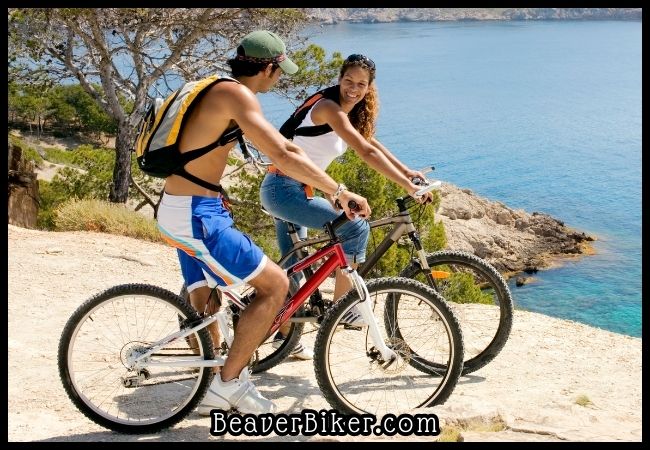

Features
One of the most noticeable features of cruiser bikes is their classic design, often featuring a curved frame and wide, swept-back handlebars. The frame is typically made of steel or aluminum, providing a sturdy and durable ride.
Most cruiser bikes have a single gear or a limited number of gears and are equipped with coaster brakes for simple stopping control.
An oversized saddle with springs adds to the overall comfort and ride quality of these bikes.
Pros and Cons
There are numerous advantages to choosing a cruiser bike for your outdoor adventures.
Pros:
Some of the pros include:
- Comfort: The upright seating position and wide saddle make for a comfortable ride.
- Style: Cruiser bikes often feature retro designs and eye-catching colors.
- Low maintenance: With fewer gears and components, these bikes tend to require less maintenance than other bike types.
Cons:
However, there are also some drawbacks to consider when contemplating a cruiser bike:
- Weight: The steel or aluminum frame can make these bikes heavier than other types, which can impact maneuverability and tire lifespan
- Speed: Due to their design and limited gearing, cruiser bikes may not be as fast as other bike types.
- Not ideal for long distances or hilly terrain: The relaxed design and single gear make cruiser bikes less suitable for long rides or tackling steep inclines.
Best Suited For
Cruiser bikes are best suited for casual, short-distance rides and commutes. They are an excellent choice for riders who prioritize comfort, style, and a laid-back riding experience. Ideal situations for cruiser bikes include:
- Riding along beachside paths or boardwalks
- Exploring your local neighborhood or park
- Short commutes to work or running errands around town
5. Touring Biking
Touring bikes are specifically designed for comfortable, long-distance travel on various terrains. These bikes are built with a focus on stability and carrying heavy loads, making them an ideal choice for extended adventures.
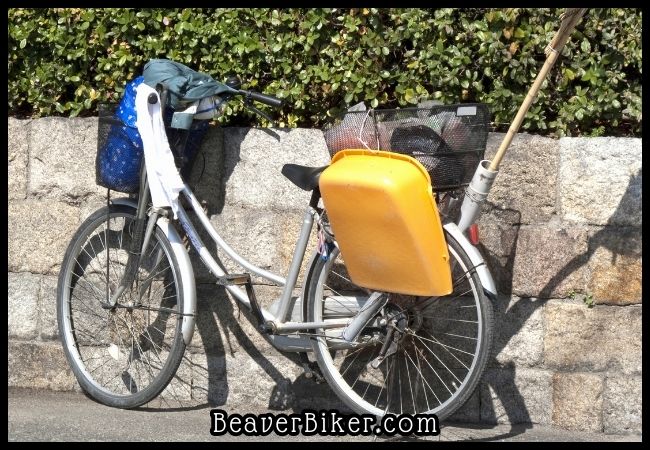

Features
These bikes typically have a steel frame, drop bars, and wide-range drivetrains with up to 30 gears, helping riders easily tackle different terrains and maintain balance when carrying luggage. Their geometry is designed to ensure stability while riding with heavy loads.
Additionally, touring bikes have various attachment points for racks, fenders, and water bottle holders to accommodate the needs of a long journey.
Pros and Cons
Pros:
- Stability and comfort for long-distance rides
- Wide range of gears for tackling varied terrains
- Built to carry heavy loads
- Attachment points for necessary gear
Cons:
- Heavier than other types of outdoor bikes due to sturdy frame
- Less agile in comparison to lighter bike options
Best Suited For
Touring bikes are best suited for individuals and families planning long-distance cycling trips that require carrying significant gear or luggage.
These outdoor bikes are also ideal for those with a desire for comfortable rides and a focus on functionality rather than speed.
6. BMX
Features
BMX bikes, short for bike motocross, are designed for off-road racing, stunt riding, and freestyle tricks.
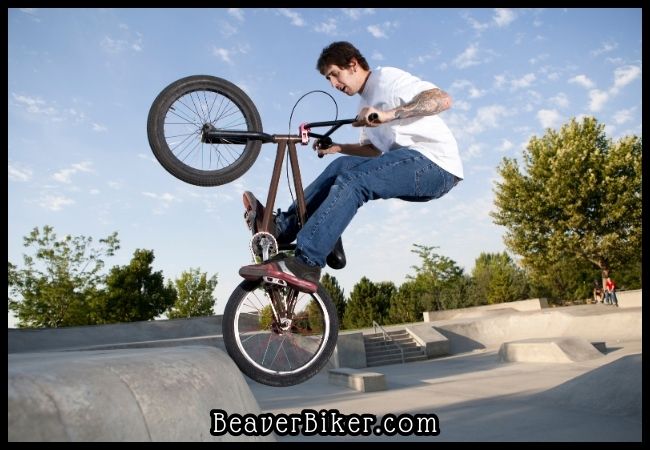

This type of outdoor bikes typically have a lightweight and rugged frame, with smaller wheels and a lower center of gravity for better handling and maneuverability.
The frames are often made from steel or aluminum, depending on the type of BMX bike and its intended use. Most BMX bikes feature a single-speed drivetrain and powerful brakes for better control during jumps and tricks.
Pros:
There are several advantages to BMX bikes that make them popular among riders.
- The lightweight and sturdy design allows for easy handling and control when performing tricks or navigating difficult terrain.
- BMX bikes are also often more affordable than other types of outdoor bikes, making them accessible to a wider range of riders.
Cons:
- On the other hand, BMX bikes may not be suitable for long-distance rides or commutes due to their lack of gears and comfortable riding position.
- The smaller wheel size can make them less stable for larger riders or when riding at higher speeds.
- Riders may also experience difficulty climbing steep hills or handling rough terrains, as the single-speed drivetrain limits their ability to adjust gears to the appropriate level.
Best Suited For
BMX bikes are ideal for riders who enjoy performing stunts or racing on off-road tracks. They are best suited for those looking to develop their skills in bike handling and control, particularly on dirt jump tracks or skate parks.
Additionally, BMX bikes are a popular choice among younger riders, as they are often more affordable and offer opportunities for developing their riding skills in a fun and challenging way.
7. Gravel Bikes
Gravel bikes are a versatile and increasingly popular choice for outdoor cycling enthusiasts. These outdoor bikes combine features of road, mountain, and cyclocross bikes, making them well-suited for various terrains and conditions.
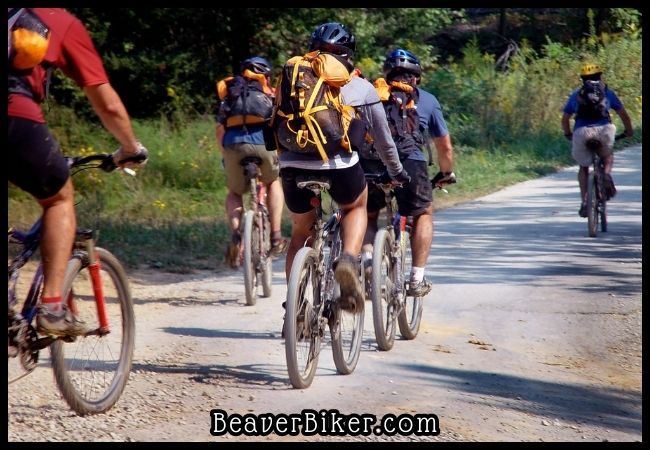

Features
Gravel bikes typically come with either 700c or 650b wheels, with the larger 700c size being more common. These outdoor bikes often have wider tires for improved cushion and traction.
The geometry of gravel bikes is designed to offer a comfortable and stable ride, while still providing efficient pedaling performance.
Additionally, most gravel bikes have disc brakes for reliable stopping power in all weather conditions.
You will also find ample mounts for accessories, such as bottles, bags, and fenders, making them suitable for long-distance rides and bike packing adventures.
Pros and Cons
Pros:
Some advantages of gravel bikes include:
- Versatility: They can handle a variety of terrains and surfaces, from pavement to dirt and gravel.
- Comfort: Their geometry and wider tires provide a smoother ride on rough surfaces.
- Practicality: With mounting options for various accessories, these outdoor bikes can be easily adapted for touring, commuting, or bike packing.
Cons:
However, gravel bikes do have a few drawbacks:
- Weight: They can be slightly heavier than traditional road bikes due to their sturdier frames and wider tires.
- Speed: On smooth pavement, they may be slower than dedicated road bikes due to their wider tires and more relaxed geometry.
Best Suited For
Gravel bikes are ideal for riders who want a single bike that can handle various terrains without compromising too much on speed or efficiency.
These outdoor bikes are a great choice for those who enjoy both road and off-road cycling, as well as long-distance riding, touring, and bike packing.
Some of the top gravel bikes on the market, according to OutdoorGearLab and Popular Mechanics, include the Santa Cruz Stigmata, Cannondale Topstone Carbon, and Trek Checkpoint SL.
Choosing the Right Bike
When selecting the perfect outdoor bike, several factors play a crucial role in ensuring a comfortable and enjoyable experience.
In this section, we will discuss essential criteria such as frame size, wheel size, gear ratios, and suspension.
Frame Size
Choosing the correct frame size is paramount, as it directly affects your comfort, riding efficiency, and safety. Your height and body measurements heavily influence the correct frame size for you.
To find the best fit, measure your inseam, and use a bike size chart specific to the type of outdoor bikes you’re interested in.
Wheel Size
Wheel size also plays a vital role in your biking experience. Various wheel sizes cater to specific types of riding. Common sizes include:
- 26-inch wheels: Often found on mountain bikes, these offer good stability and quick acceleration.
- 27.5-inch (or 650b) wheels: A popular choice for mountain bikes, providing a balance between stability, acceleration, and roll-over capability.
- 29-inch wheels: Common on mountain and hybrid bikes, these deliver better roll-over ability on rough terrain, but may feel slower to accelerate.
- 700c wheels: Typically found on road bikes and some hybrids, these offer a fast, smooth ride on pavement.
Consider your riding preferences and the terrain you’ll be tackling when selecting the most suitable wheel size.
Gear Ratios
The ideal gear ratio depends on your cycling needs, fitness level, and the terrain you’ll be covering. Bikes come with different numbers of gears, ranging from single speed to over 30 gears.
Bikes with more gears provide a greater range of options and are suitable for varied terrains.
On the other hand, if simplicity is crucial, a single speed or fixed gear bike may be the perfect choice.
Suspension
The suspension system on bikes helps absorb shocks and vibrations, providing a smoother ride on rough terrain. There are three main types:
- Rigid: Bikes with no suspension, typically found on road bikes and some hybrids. They are lighter and require less maintenance but may offer less comfort on bumpy surfaces.
- Hardtail: Mountain bikes with front suspension forks. They provide better control and comfort when riding off-road and are suitable for various types of terrain.
- Full suspension: Mountain bikes with both front and rear suspension systems. These offer the most comfortable ride on rough terrain but can be heavier and require more maintenance.
Consider the type of riding you plan to do and the terrain conditions to choose the best suspension system for your needs.
By understanding the key differences between these types of outdoor bikes, we can make an informed decision and choose a bike that suits our individual needs and preferences.


Explore more in your next biking experience:
🚲Road Bikes
🚲Mountain Bikes
🚲BMX

